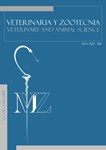Authors
Abstract
The crossing of Bos taurus x Bos indicus cattle, in this specific case Holstein x different Zebu breeds, are a great option of profitability for Colombia to face the challenge of the free trade agreement with Europe. The total benefit that accompanies the filial generation one is explained by the greatest heterosis that occurs in it, because it has the 100% of its loci taken by one gene of each breed crossed, resulting in the greatest racial heterozygosis possible. Holstein is the breed with the greatest known potential for milk production if it receives the necessary quantity of energy; but profitability not only can be measured from that point of view because there are other indicators that affect the production economic level. Besides, the benefits already known given by zebu breeds such as rusticity, resistance to infectious agents and decrease of requirements, this paper puts together information of economic importance about the performance of these crosses, such as calving interval, age at first calving, milk yield and terminal crosses calves weight.
References
Bedoya, M; Benavides, H; Cabrera, M. et al. Segunda Comunicación Nacional ante la Convención Marco de las Naciones Unidas sobre Cambio Climático. 2008. Disponible en:
http://www. crid.or.cr/digitalizacion/pdf/spa/doc18157/ doc18157-e.pdf Accesado en: 18/11/2011.
Bell, M.J; Wall, E.; Russell, G. et al. The effect of improving cow productivity, fertility, and longevity on the global warming potential of dairy systems. Journal of Dairy Science, v.94, n.7, p. 3662-3678, 2011.
Dickerson, G.E. Experimental approaches in utilizing breed resources. Animal Breeding Abstracts, v.37, p.191-202, 1969.Evans, R.D.; Buckley, F.; Dillon, P.; Veerkamp,R.F. Genetic parameters for production and reproduction of spring-calving upgraded Holstein-Friesian dairy cows in Ireland. Irish Journal of Agricultural and Food Research, v.41, p.43-54, 2002.
Facó, O.; Lôbo, R.N.B.; Martins Filho, R. et al. Idade ao Primeiro Parto e Intervalo de Partos de Cinco Grupos Genéticos Holandês x Gir no Brasil. Revista Brasileira de Zootecnia, v.34, n.6, p.1920-1926, 2005.
FEDEGAN. Orientación del hato colombiano por actividad ganadera. 2007. Disponible en: http:// portal.fedegan.org.co/PEGA_Regionales/02_ resentaciones/Mapas%20Ganaderos%20 Geograficos.pdf Accesado en: 03/07/2011. Gasque-Gómez, R. Enciclopedia Bovina. 1.ed. México: Centro Editorial Universidad Nacional Autónoma de México, 2008. 400p.
Gill, M.; Smith, P.; y Wilkinson, J.M. Mitigating climate change: the role of domestic livestock. Animal, v.4, p.323-333, 2009.
Gonzales-Stagnaro, C.; Madrid- Bury, N.J.; Goicochea-Llaque, J.; Gonzales-Villalobos, D.; Rodriguez-Urbina, M. Primer Servicio en Novillas de Doble propósito. Revista Científica, p.39-46, 2007.
Grajales, H.; Hernández, A.; Prieto, E. Age and weight at puberty and their relation with reproductive efficiency cattle breeds in the Colombian tropics. Livestock Research for Rural Development, v.18, n.3, 2006.
Guimarães, P.H.; Madalena, F.E. & Cezar, I. Comparative economics of Holstein/Gir F1 dairy female production and conventional beef cattle suckler herds – A simulation study. Agricultural Systems, v.88, p.11-124, 2006.
Hoekstra, J.; Van der Lugt, A.W.; Van der Werf, J.H.J; Ouweltjes, W. Genetic and phenotypic parameters for milk production and fertility traits in upgraded dairy cattle. Livestock Production Science. v.40, p.225-232, 1994.
Lobo, R.B.; Duarte, F.A.M.; Gonçalves, A.A.M.; Oliveira, J.A.; Wilcox, C.J. Genetic and environmental effects on milk yield of Pitangueiras cattle. Animal Production, v.39, p.157-163,1984.
Madalena, F.E. ¿Por qué la F1? 1993. Disponible en: http://www.fernandomadalena.com/site_ arquivos/011.pdf Accesado en: 18/08/2011. Madalena, F.E. Consideraciones sobre modelos para la predicción del desempeño de cruzamientos en bovinos. Archivos Latinoamericanos de Producción Animal, v.9, n.2, p.108-117, 2001.
Madalena, F.E. A simple scheme to utilize heterosis in tropical dairy cattle. 2005. Disponible en: http:// www.fao.org/ag/aga/agap/frg/feedback/war/ u9550b/u9550b0a.htm Accesado en: 05/07/2011.
Madalena, F.E.; Lemos, A.M.; Teodoro, R.L. Effect of cost-price structure on the relative economic performance of alternative dairy cattle crossbreeding strategies. Brazilian Journal of Genetics, v.12, p.887-893,1989.
Madalena, F.E.; Lemos, A.M.; Teodoro, R.L.; Barbosa, R.T.; Monteiro, J.B.N. Dairy Production and Reproduction in Holstein-Friesian and Guzera Crosses. Journal of Dairy Science 73, v.73, n.7, p.1872-1886, 1990.
Madalena, F.E.; Reis, G.; Melo, F.E. Predicción del peso vivo a partir de medidas corporales en animales mestizos Holstein/Gir. Ciencia Rural, v.38, n.003, 2008.
Mahecha, L.; Escobar, J.P.; Suárez, J.F.; Restrepo, L.F. Tithonia diversifolia (hemsl.) Gray (botón de oro) como suplemento forrajero de vacas F1 (Holstein por Cebú). Livestock Research for Rural Development, v.19, n.16, 2007.
McDowell, R.E. Bases biológicas para la producción animal en zonas tropicales. 1 ed. Zaragoza, España: Editorial Acribia, 1974. 351p.
McManus, C.; De Almeida-Teixeira, R.; TalaricoDias, L.; Louvandini, H.; Bianchini-Oliveira, E.M. Características produtivas e reprodutivas de vacas Holandesas e mestiças Holandês × Gir no Planalto Central. Revista Brasileira de Zootecnia, v.37, n.5, p.819-823, 2008.
Oltenacu, P.A.; Broom, D.M. The impact of genetic selection for increased milk yield on the welfare of dairy cows. Animal Welfare. v.19, p.39-49, 2010.
Osorio, M.; Segura, J. Reproductive performance of dual-purpose cows in Yucatan, México. Livestock Research for Rural Development, v.14, n.2, 2002.
Pardo, O.; Sánchez, J. Evaluación de leche y/o carne de diferentes grupos raciales en el trópico bajo colombiano. Ecosistema valle medio del Sinú. Bogotá, Colombia: Universidad Nacional de Colombia, 1987. Trabajo de Grado (Medicina Veterinaria).
Ruas, J.R.M.; Amarral, R.; Neto, A.; Ferreira, J.J. Produção de leite e bezerro comercial com vacas F1 holandês-zebu. XXVI Encuontro de Médicos Veterinarios y Zootecnistas-Mayo de 2005Values do Mucuri, Jequitinhonha y Rio Doce. Resumen en evento internacional, 2005.
Salazar, D.; Huertas, E. Eficiencia de las razas Holstein, Pardo Suizo y Costeño con Cuernos para producción de leche en el trópico. Revista ICA, v.14, n.4, p.247-253, 1979.
United Nations Framework Convention on Climate Change (UNFCCC) http://unfccc.int/ files/national_ reports/ nonannex_i_natcom/ ubmitted_natcom/application/pdf/executive_ summary_spanish.pdf 2008.
Yuliska, Y.; Rodríguez, G.; Martínez, G. Efecto de la Edad al Primer Parto, Grupo racial y algunos factores ambientales sobre la Producción de leche y El Primer intervalo Entre Partos En vacas doble Propósito. Revista de la Facultad de Ciencias Veterinarias Universidad Central de Venezuela, v.51, n.2, p.79-91, 2010.

 PDF (Español)
PDF (Español)
 FLIP
FLIP










